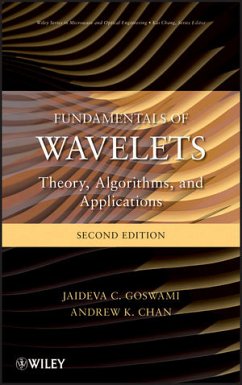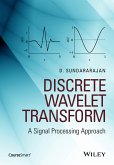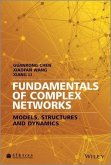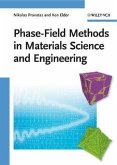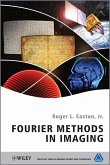Jaideva C. Goswami, Andrew K. Chan
Fundamentals of Wavelets (eBook, ePUB)
Theory, Algorithms, and Applications
122,99 €
122,99 €
inkl. MwSt.
Sofort per Download lieferbar

0 °P sammeln
122,99 €
Als Download kaufen

122,99 €
inkl. MwSt.
Sofort per Download lieferbar

0 °P sammeln
Jetzt verschenken
Alle Infos zum eBook verschenken
122,99 €
inkl. MwSt.
Sofort per Download lieferbar
Alle Infos zum eBook verschenken

0 °P sammeln
Jaideva C. Goswami, Andrew K. Chan
Fundamentals of Wavelets (eBook, ePUB)
Theory, Algorithms, and Applications
- Format: ePub
- Merkliste
- Auf die Merkliste
- Bewerten Bewerten
- Teilen
- Produkt teilen
- Produkterinnerung
- Produkterinnerung

Bitte loggen Sie sich zunächst in Ihr Kundenkonto ein oder registrieren Sie sich bei
bücher.de, um das eBook-Abo tolino select nutzen zu können.
Hier können Sie sich einloggen
Hier können Sie sich einloggen
Sie sind bereits eingeloggt. Klicken Sie auf 2. tolino select Abo, um fortzufahren.

Bitte loggen Sie sich zunächst in Ihr Kundenkonto ein oder registrieren Sie sich bei bücher.de, um das eBook-Abo tolino select nutzen zu können.
Most existing books on wavelets are either too mathematical or they focus on too narrow a specialty. This book provides a thorough treatment of the subject from an engineering point of view. It is a one-stop source of theory, algorithms, applications, and computer codes related to wavelets. This second edition has been updated by the addition of: a section on "Other Wavelets" that describes curvelets, ridgelets, lifting wavelets, etc | a section on lifting algorithms | Sections on Edge Detection and Geophysical Applications | Section on Multiresolution Time Domain Method (MRTD) and on Inverse problems …mehr
- Geräte: eReader
- ohne Kopierschutz
- eBook Hilfe
Andere Kunden interessierten sich auch für
![Fundamentals of Wavelets (eBook, PDF) Fundamentals of Wavelets (eBook, PDF)]() Jaideva C. GoswamiFundamentals of Wavelets (eBook, PDF)122,99 €
Jaideva C. GoswamiFundamentals of Wavelets (eBook, PDF)122,99 €![Discrete Wavelet Transform (eBook, ePUB) Discrete Wavelet Transform (eBook, ePUB)]() D. SundararajanDiscrete Wavelet Transform (eBook, ePUB)95,99 €
D. SundararajanDiscrete Wavelet Transform (eBook, ePUB)95,99 €![Essential Math Skills for Engineers (eBook, ePUB) Essential Math Skills for Engineers (eBook, ePUB)]() Clayton R. PaulEssential Math Skills for Engineers (eBook, ePUB)47,99 €
Clayton R. PaulEssential Math Skills for Engineers (eBook, ePUB)47,99 €![Practical Design of Magnetostatic Structure Using Numerical Simulation (eBook, ePUB) Practical Design of Magnetostatic Structure Using Numerical Simulation (eBook, ePUB)]() Qiuliang WangPractical Design of Magnetostatic Structure Using Numerical Simulation (eBook, ePUB)111,99 €
Qiuliang WangPractical Design of Magnetostatic Structure Using Numerical Simulation (eBook, ePUB)111,99 €![Fundamentals of Complex Networks (eBook, ePUB) Fundamentals of Complex Networks (eBook, ePUB)]() Guanrong ChenFundamentals of Complex Networks (eBook, ePUB)100,99 €
Guanrong ChenFundamentals of Complex Networks (eBook, ePUB)100,99 €![Phase-Field Methods in Materials Science and Engineering (eBook, ePUB) Phase-Field Methods in Materials Science and Engineering (eBook, ePUB)]() Nikolas ProvatasPhase-Field Methods in Materials Science and Engineering (eBook, ePUB)135,99 €
Nikolas ProvatasPhase-Field Methods in Materials Science and Engineering (eBook, ePUB)135,99 €![Fourier Methods in Imaging (eBook, ePUB) Fourier Methods in Imaging (eBook, ePUB)]() Roger L. Easton Jr.Fourier Methods in Imaging (eBook, ePUB)138,99 €
Roger L. Easton Jr.Fourier Methods in Imaging (eBook, ePUB)138,99 €-
-
-
Most existing books on wavelets are either too mathematical or they focus on too narrow a specialty. This book provides a thorough treatment of the subject from an engineering point of view. It is a one-stop source of theory, algorithms, applications, and computer codes related to wavelets. This second edition has been updated by the addition of:
Hinweis: Dieser Artikel kann nur an eine deutsche Lieferadresse ausgeliefert werden.
- a section on "Other Wavelets" that describes curvelets, ridgelets, lifting wavelets, etc
- a section on lifting algorithms
- Sections on Edge Detection and Geophysical Applications
- Section on Multiresolution Time Domain Method (MRTD) and on Inverse problems
Dieser Download kann aus rechtlichen Gründen nur mit Rechnungsadresse in D ausgeliefert werden.
Hinweis: Dieser Artikel kann nur an eine deutsche Lieferadresse ausgeliefert werden.
Produktdetails
- Produktdetails
- Verlag: Jossey-Bass
- Erscheinungstermin: 8. März 2011
- Englisch
- ISBN-13: 9780470934647
- Artikelnr.: 37300908
- Verlag: Jossey-Bass
- Erscheinungstermin: 8. März 2011
- Englisch
- ISBN-13: 9780470934647
- Artikelnr.: 37300908
- Herstellerkennzeichnung Die Herstellerinformationen sind derzeit nicht verfügbar.
Jaideva C. Goswami, PhD, is an Engineering Advisor at Schlumberger in Sugarland, Texas. He is also a former professor of Electronics and Communication Engineering at the Indian Institute of Technology, Kharagpur. Dr. Goswami has taught several short courses on wavelets and contributed to the Wiley Encyclopedia of Electrical and Electronics Engineering as well as Wiley Encyclopedia of RF and Microwave Engineering. He has many research papers and patents to his credit, and is a Fellow of IEEE.
Andrew K. Chan, PhD, is on the faculty of Texas A&M University and is the coauthor of Wavelets in a Box and Wavelet Toolware. He is a Life Fellow of IEEE.
Andrew K. Chan, PhD, is on the faculty of Texas A&M University and is the coauthor of Wavelets in a Box and Wavelet Toolware. He is a Life Fellow of IEEE.
1.What is this book all about?
2. Mathematical Preliminary.
2.1 Linear Spaces.
2.2 Vectors and Vector Spaces.
2.3 Basis Functions, Orthogonality and Biothogonality.
2.4 Local Basis and Riesz Basis.
2.5 Discrete Linear Normed Space.
2.6 Approximation by Orthogonal Projection.
2.7 Matrix Algebra and Linear Transformation.
2.8 Digital Signals.
2.9 Exercises.
2.10 References.
3. Fourier Analysis.
3.1 Fourier Series.
3.2 Rectified Sine Wave.
3.3 Fourier Transform.
3.4 Properties of Fourier Transform.
3.5 Examples of Fourier Transform.
3.6 Poisson's Sum and Partition of ZUnity.
3.7 Sampling Theorem.
3.8 Partial Sum and Gibb's Phenomenon.
3.9 Fourier Analysis of Discrete-Time Signals.
3.10 Discrete Fourier Transform (DFT).
3.11 Exercise.
3.12 References.
4. Time-Frequency Analysis.
4.1 Window Function.
4.2 Short-Time Fourier Transform.
4.3 Discrete Short-Time Fourier Transform.
4.4 Discrete Gabor Representation.
4.5 Continuous Wavelet Transform.
4.6 Discrete Wavelet Transform.
4.7 Wavelet Series.
4.8 Interpretations of the Time-Frequency Plot.
4.9 Wigner-Ville Distribution.
4.10 Properties of Wigner-Ville Distribution.
4.11 Quadratic Superposition Principle.
4.12 Ambiguity Function.
4.13 Exercise.
4.14 Computer Programs.
4.15 References.
5. Multiresolution Anaylsis.
5.1 Multiresolution Spaces.
5.2 Orthogonal, Biothogonal, and Semiorthogonal Decomposition.
5.3 Two-Scale Relations.
5.4 Decomposition Relation.
5.5 Spline Functions and Properties.
5.6 Mapping a Function into MRA Space.
5.7 Exercise.
5.8 Computer Programs.
5.9 References.
6. Construction of Wavelets.
6.1 Necessary Ingredients for Wavelet Construction.
6.2 Construction of Semiorthogonal Spline Wavelets.
6.3 Construction of Orthonormal Wavelets.
6.4 Orthonormal Scaling Functions.
6.5 Construction of Biothogonal Wavelets.
6.6 Graphical Display of Wavelet.
6.7 Exercise.
6.8 Computer Programs.
6.9 References.
7. DWT and Filter Bank Algorithms.
7.1 Decimation and Interpolation.
7.2 Signal Representation in the Approximation Subspace.
7.3 Wavelet Decomposition Algorithm.
7.4 Reconstruction Algorithm.
7.5 Change of Bases.
7.6 Signal Reconstruction in Semiorthogonal Subspaces.
7.7 Examples.
7.8 Two-Channel Perfect Reconstruction Filter Bank.
7.9 Polyphase Representation for Filter Banks.
7.10 Comments on DWT and PR Filter Banks.
7.11 Exercise.
7.12 Computer Program.
7.13 References.
8. Special Topics in Wavelets and Algorithms.
8.1 Fast Integral Wavelet Transform.
8.2 Ridgelet Transform.
8.3 Curvelet Transform.
8.4 Complex Wavelets.
8.5 Lifting Wavelet transform.
8.6 References.
9. Digital Signal Processing Applications.
9.1 Wavelet Packet.
9.2 Wavelet-Packet Algorithms.
9.3 Thresholding.
9.4 Interference Suppression.
9.5 Faulty Bearing Signature Identification.
9.6 Two-Dimensional Wavelets and Wavelet Packets.
9.7 Edge Detection.
9.8 Image Compression.
9.9 Microcalcification Cluster Detection.
2. Mathematical Preliminary.
2.1 Linear Spaces.
2.2 Vectors and Vector Spaces.
2.3 Basis Functions, Orthogonality and Biothogonality.
2.4 Local Basis and Riesz Basis.
2.5 Discrete Linear Normed Space.
2.6 Approximation by Orthogonal Projection.
2.7 Matrix Algebra and Linear Transformation.
2.8 Digital Signals.
2.9 Exercises.
2.10 References.
3. Fourier Analysis.
3.1 Fourier Series.
3.2 Rectified Sine Wave.
3.3 Fourier Transform.
3.4 Properties of Fourier Transform.
3.5 Examples of Fourier Transform.
3.6 Poisson's Sum and Partition of ZUnity.
3.7 Sampling Theorem.
3.8 Partial Sum and Gibb's Phenomenon.
3.9 Fourier Analysis of Discrete-Time Signals.
3.10 Discrete Fourier Transform (DFT).
3.11 Exercise.
3.12 References.
4. Time-Frequency Analysis.
4.1 Window Function.
4.2 Short-Time Fourier Transform.
4.3 Discrete Short-Time Fourier Transform.
4.4 Discrete Gabor Representation.
4.5 Continuous Wavelet Transform.
4.6 Discrete Wavelet Transform.
4.7 Wavelet Series.
4.8 Interpretations of the Time-Frequency Plot.
4.9 Wigner-Ville Distribution.
4.10 Properties of Wigner-Ville Distribution.
4.11 Quadratic Superposition Principle.
4.12 Ambiguity Function.
4.13 Exercise.
4.14 Computer Programs.
4.15 References.
5. Multiresolution Anaylsis.
5.1 Multiresolution Spaces.
5.2 Orthogonal, Biothogonal, and Semiorthogonal Decomposition.
5.3 Two-Scale Relations.
5.4 Decomposition Relation.
5.5 Spline Functions and Properties.
5.6 Mapping a Function into MRA Space.
5.7 Exercise.
5.8 Computer Programs.
5.9 References.
6. Construction of Wavelets.
6.1 Necessary Ingredients for Wavelet Construction.
6.2 Construction of Semiorthogonal Spline Wavelets.
6.3 Construction of Orthonormal Wavelets.
6.4 Orthonormal Scaling Functions.
6.5 Construction of Biothogonal Wavelets.
6.6 Graphical Display of Wavelet.
6.7 Exercise.
6.8 Computer Programs.
6.9 References.
7. DWT and Filter Bank Algorithms.
7.1 Decimation and Interpolation.
7.2 Signal Representation in the Approximation Subspace.
7.3 Wavelet Decomposition Algorithm.
7.4 Reconstruction Algorithm.
7.5 Change of Bases.
7.6 Signal Reconstruction in Semiorthogonal Subspaces.
7.7 Examples.
7.8 Two-Channel Perfect Reconstruction Filter Bank.
7.9 Polyphase Representation for Filter Banks.
7.10 Comments on DWT and PR Filter Banks.
7.11 Exercise.
7.12 Computer Program.
7.13 References.
8. Special Topics in Wavelets and Algorithms.
8.1 Fast Integral Wavelet Transform.
8.2 Ridgelet Transform.
8.3 Curvelet Transform.
8.4 Complex Wavelets.
8.5 Lifting Wavelet transform.
8.6 References.
9. Digital Signal Processing Applications.
9.1 Wavelet Packet.
9.2 Wavelet-Packet Algorithms.
9.3 Thresholding.
9.4 Interference Suppression.
9.5 Faulty Bearing Signature Identification.
9.6 Two-Dimensional Wavelets and Wavelet Packets.
9.7 Edge Detection.
9.8 Image Compression.
9.9 Microcalcification Cluster Detection.
1.What is this book all about?
2. Mathematical Preliminary.
2.1 Linear Spaces.
2.2 Vectors and Vector Spaces.
2.3 Basis Functions, Orthogonality and Biothogonality.
2.4 Local Basis and Riesz Basis.
2.5 Discrete Linear Normed Space.
2.6 Approximation by Orthogonal Projection.
2.7 Matrix Algebra and Linear Transformation.
2.8 Digital Signals.
2.9 Exercises.
2.10 References.
3. Fourier Analysis.
3.1 Fourier Series.
3.2 Rectified Sine Wave.
3.3 Fourier Transform.
3.4 Properties of Fourier Transform.
3.5 Examples of Fourier Transform.
3.6 Poisson's Sum and Partition of ZUnity.
3.7 Sampling Theorem.
3.8 Partial Sum and Gibb's Phenomenon.
3.9 Fourier Analysis of Discrete-Time Signals.
3.10 Discrete Fourier Transform (DFT).
3.11 Exercise.
3.12 References.
4. Time-Frequency Analysis.
4.1 Window Function.
4.2 Short-Time Fourier Transform.
4.3 Discrete Short-Time Fourier Transform.
4.4 Discrete Gabor Representation.
4.5 Continuous Wavelet Transform.
4.6 Discrete Wavelet Transform.
4.7 Wavelet Series.
4.8 Interpretations of the Time-Frequency Plot.
4.9 Wigner-Ville Distribution.
4.10 Properties of Wigner-Ville Distribution.
4.11 Quadratic Superposition Principle.
4.12 Ambiguity Function.
4.13 Exercise.
4.14 Computer Programs.
4.15 References.
5. Multiresolution Anaylsis.
5.1 Multiresolution Spaces.
5.2 Orthogonal, Biothogonal, and Semiorthogonal Decomposition.
5.3 Two-Scale Relations.
5.4 Decomposition Relation.
5.5 Spline Functions and Properties.
5.6 Mapping a Function into MRA Space.
5.7 Exercise.
5.8 Computer Programs.
5.9 References.
6. Construction of Wavelets.
6.1 Necessary Ingredients for Wavelet Construction.
6.2 Construction of Semiorthogonal Spline Wavelets.
6.3 Construction of Orthonormal Wavelets.
6.4 Orthonormal Scaling Functions.
6.5 Construction of Biothogonal Wavelets.
6.6 Graphical Display of Wavelet.
6.7 Exercise.
6.8 Computer Programs.
6.9 References.
7. DWT and Filter Bank Algorithms.
7.1 Decimation and Interpolation.
7.2 Signal Representation in the Approximation Subspace.
7.3 Wavelet Decomposition Algorithm.
7.4 Reconstruction Algorithm.
7.5 Change of Bases.
7.6 Signal Reconstruction in Semiorthogonal Subspaces.
7.7 Examples.
7.8 Two-Channel Perfect Reconstruction Filter Bank.
7.9 Polyphase Representation for Filter Banks.
7.10 Comments on DWT and PR Filter Banks.
7.11 Exercise.
7.12 Computer Program.
7.13 References.
8. Special Topics in Wavelets and Algorithms.
8.1 Fast Integral Wavelet Transform.
8.2 Ridgelet Transform.
8.3 Curvelet Transform.
8.4 Complex Wavelets.
8.5 Lifting Wavelet transform.
8.6 References.
9. Digital Signal Processing Applications.
9.1 Wavelet Packet.
9.2 Wavelet-Packet Algorithms.
9.3 Thresholding.
9.4 Interference Suppression.
9.5 Faulty Bearing Signature Identification.
9.6 Two-Dimensional Wavelets and Wavelet Packets.
9.7 Edge Detection.
9.8 Image Compression.
9.9 Microcalcification Cluster Detection.
2. Mathematical Preliminary.
2.1 Linear Spaces.
2.2 Vectors and Vector Spaces.
2.3 Basis Functions, Orthogonality and Biothogonality.
2.4 Local Basis and Riesz Basis.
2.5 Discrete Linear Normed Space.
2.6 Approximation by Orthogonal Projection.
2.7 Matrix Algebra and Linear Transformation.
2.8 Digital Signals.
2.9 Exercises.
2.10 References.
3. Fourier Analysis.
3.1 Fourier Series.
3.2 Rectified Sine Wave.
3.3 Fourier Transform.
3.4 Properties of Fourier Transform.
3.5 Examples of Fourier Transform.
3.6 Poisson's Sum and Partition of ZUnity.
3.7 Sampling Theorem.
3.8 Partial Sum and Gibb's Phenomenon.
3.9 Fourier Analysis of Discrete-Time Signals.
3.10 Discrete Fourier Transform (DFT).
3.11 Exercise.
3.12 References.
4. Time-Frequency Analysis.
4.1 Window Function.
4.2 Short-Time Fourier Transform.
4.3 Discrete Short-Time Fourier Transform.
4.4 Discrete Gabor Representation.
4.5 Continuous Wavelet Transform.
4.6 Discrete Wavelet Transform.
4.7 Wavelet Series.
4.8 Interpretations of the Time-Frequency Plot.
4.9 Wigner-Ville Distribution.
4.10 Properties of Wigner-Ville Distribution.
4.11 Quadratic Superposition Principle.
4.12 Ambiguity Function.
4.13 Exercise.
4.14 Computer Programs.
4.15 References.
5. Multiresolution Anaylsis.
5.1 Multiresolution Spaces.
5.2 Orthogonal, Biothogonal, and Semiorthogonal Decomposition.
5.3 Two-Scale Relations.
5.4 Decomposition Relation.
5.5 Spline Functions and Properties.
5.6 Mapping a Function into MRA Space.
5.7 Exercise.
5.8 Computer Programs.
5.9 References.
6. Construction of Wavelets.
6.1 Necessary Ingredients for Wavelet Construction.
6.2 Construction of Semiorthogonal Spline Wavelets.
6.3 Construction of Orthonormal Wavelets.
6.4 Orthonormal Scaling Functions.
6.5 Construction of Biothogonal Wavelets.
6.6 Graphical Display of Wavelet.
6.7 Exercise.
6.8 Computer Programs.
6.9 References.
7. DWT and Filter Bank Algorithms.
7.1 Decimation and Interpolation.
7.2 Signal Representation in the Approximation Subspace.
7.3 Wavelet Decomposition Algorithm.
7.4 Reconstruction Algorithm.
7.5 Change of Bases.
7.6 Signal Reconstruction in Semiorthogonal Subspaces.
7.7 Examples.
7.8 Two-Channel Perfect Reconstruction Filter Bank.
7.9 Polyphase Representation for Filter Banks.
7.10 Comments on DWT and PR Filter Banks.
7.11 Exercise.
7.12 Computer Program.
7.13 References.
8. Special Topics in Wavelets and Algorithms.
8.1 Fast Integral Wavelet Transform.
8.2 Ridgelet Transform.
8.3 Curvelet Transform.
8.4 Complex Wavelets.
8.5 Lifting Wavelet transform.
8.6 References.
9. Digital Signal Processing Applications.
9.1 Wavelet Packet.
9.2 Wavelet-Packet Algorithms.
9.3 Thresholding.
9.4 Interference Suppression.
9.5 Faulty Bearing Signature Identification.
9.6 Two-Dimensional Wavelets and Wavelet Packets.
9.7 Edge Detection.
9.8 Image Compression.
9.9 Microcalcification Cluster Detection.
